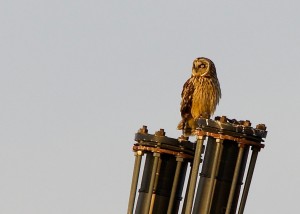Jim Wright, who keeps this blog for the Meadowlands Commission, also writes a twice-monthly column for the South Bergenite. His most recent column is on Short-eared Owls:
This winter has been the season of the snowy owl, which has been visiting the Garden State from the Arctic in record numbers. But the Meadowlands have been blessed with frequent appearances by another invader from the north, the short-eared owl.
Most of these nocturnal raptors have apparently moved elsewhere but they put on a great show while they were here.
The best place to see the medium-sized owls was from Disposal Road (which runs from Schuyler Avenue in North Arlington to Valley Brook Avenue). All you had to do to find the owls was to look for the row of photographers with Hubble-telescope-size lenses aimed at the old Kingsland Landfill.
Because these owls like to hunt by flying low over the grasses, they are a great bird to watch and to photograph.
In fact, I would have written about them sooner, but the weeks of snowy weather have narrowed that stretch of Disposal and made for difficult driving and bird-watching conditions — especially with the avian paparazzi present.
Even so, the short-eared owl is one of NJMC Naturalist Mike Newhouse’s favorite birds.
They look so majestic when they fly,” he says. “It is really amazing to watch these owls hunt. I can watch them for hours, and I have.”
Newhouse says these owls hunt with their ears more than their eyesight, flying close to the ground and listening for prey moving in the grass. When they detect something, they pounce.
According to Mike, the former landfills in the Meadowlands give this brown-and-tan owl not only the habitat it needs but also the prey — typically small mammals but occasionally birds.
The short-eared owl may not be seen often around here, but it is one of the most widely distributed owls in the world, found across North America, South America, Eurasia, and on many oceanic islands. In North America, these owls breed mainly in Canada, but winter in the United States.
Even when the owls were here, they were often tough to find.
“Usually when you think of owls, you picture them perched high in a tree, like a great-horned owl,” says Mike. “But not these guys. They sit and nest on the ground, and they’re so camouflaged that they’re difficult to detect.”
Why has this winter been so good for seeing these owls in the Meadowlands?
“The short-eared owl is usually seen in the Meadowlands every winter, but some years you see more than others,” Mike says. “These owls also go through population cycles where they can be in abundance, but then decline the following year. When the prey species population increases, you see an increase in predators the following year — or in our case, the following winter.”


